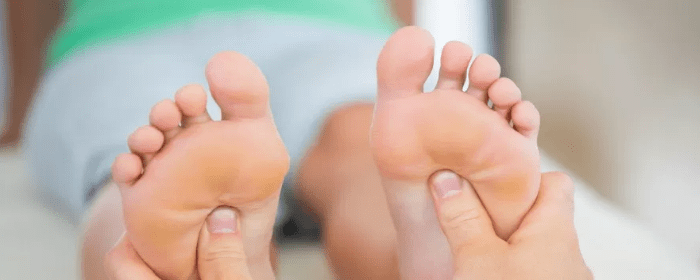
by admin | Sep 3, 2018 | Multiple Sclerosis
Foot drop, also commonly referred to as drop foot, is a condition in which the muscles that lift the foot become weak or paralyzed. As a result, the foot may drag while walking. Foot drop isn’t a disease in itself; instead, it can develop as a result of preexisting medical conditions. Learn more about what causes the symptom and how it can be treated below.
What Are the Characteristics of Foot Drop?
Because foot drop causes the front toes to drag, it often leads individuals with the condition to overcorrect their gait to avoid tripping or discomfort. They may either swing the leg outward in an arc or lift the knee higher. This coping mechanism is what’s known as “steppage gait.”
Who Might Be Affected by Foot Drop?
Foot drop can be caused by certain neurological disorders, including amyotrophic lateral sclerosis (ALS, or Lou Gehrig’s disease), Multiple Sclerosis (MS), and muscular dystrophy. These and other neurological conditions lead to weakening and deterioration of the muscles, which can cause foot drop. Cerebral palsy and stroke may also bring on foot drop.
In addition to individuals with neurological conditions, foot drop can also occur in people who have sustained nerve damage, or neuropathy. Specifically, the peroneal nerve, which extends from the sciatic nerve and wraps from behind the knee to the shin, is compromised in drop foot. There are a number of possible causes of this form of nerve damage, including diabetes, sports injuries, hip or knee replacements or time spent in a cast, long durations spent cross-legged or squatting, and childbirth.
How is it Treated?
Physicians make treatment recommendations based on the severity of the condition, as well as its root cause. While it is not always fully curable, some treatments can make noticeable improvements in gait. Leg braces may be worn to provide ample support. Patients may also benefit from attending physical therapy to perform leg and foot strengthening exercises. Certain movements can also be completed at home, including gentle stretches and chair exercises.
Sometimes, functional electrical stimulation is also used to enhance nerve functionality, which can spur muscle contraction to lift the foot. Doctors may also recommend nerve surgery if it is deemed to be a feasible solution. For individuals who would not benefit from surgery, implementing lifestyle changes such as eliminating floor clutter and ensuring homes are well-lit may be helpful.

by admin | Jul 31, 2018 | Health Awareness
A healthy diet is important for feeling your best, but for individuals with an autoimmune disorder such as multiple sclerosis (MS), healthy eating plans become even more critical. This is the belief on which the Wahls diet was founded. Developed by Dr. Terry Wahls, the diet implements paleo-style eating to aid in symptom management. Here, we learn more about the eating plan that has helped MS patients and sufferers of other autoimmune disorders manage their conditions more effectively.
How is Diet Linked to Autoimmune Diseases?
Autoimmune disorders are suspected to be caused by low-grade inflammation, or the inflammation that takes place in our cells. Research suggests that a microbial imbalance of gut flora could also contribute to autoimmunity. Eating plans such as the Wahls protocol diet aim to reduce inflammation by eliminating certain food chemicals which could contribute to gut dysbiosis and inflammation in sensitive individuals.
What Does the Wahls Diet Entail?
Like the Paleolithic (Paleo) diet, the Wahls protocol emphasizes the consumption of meat and fish and vegetables. It also encourages fat intake from both animal and plant sources and allows for brightly-colored fruits, such as berries, to be enjoyed regularly.
In order to minimize potential inflammatory agents found in common food sources, the diet is fairly restrictive. For instance, dairy products and eggs are prohibited, along with nightshade vegetables such as eggplant, tomatoes, potatoes, and peppers. Legumes, all grains, and sugars (except for those occurring naturally in fruits) are also restricted.
In recognition of the varying degree of severity in autoimmune disorders, as well as patients’ diverse food preferences and needs, Dr. Wahls has established three tiers of the diet. For instance, Level 3 calls for the elimination of all white-fleshed fruits, while Level 1 requires only the avoidance of all foods containing gluten and dairy.
Does the Diet Really Work?
In patients with MS, following a paleo-style diet has been shown to improve fatigue. Yet, because subjects involved in clinical studies are also typically receiving additional forms of therapy, it is difficult to isolate dietary tactics alone as the primary agent for achieving results. Nonetheless, Dr. Wahls attributes the diet to her own reversal of symptoms. Before she embarked on a healthier eating plan, Dr. Wahls’ muscles had weakened to the point at which she needed a tilt-recline wheelchair. After transforming her diet, she was able to bike nearly 20 miles a day.
While research on the complex ways in which dietary choices impact immune functionality is still ongoing. For patients with autoimmune disorders like MS, talking to doctors about anti-inflammatory eating plans is certainly not a bad idea. Beyond aiding with symptom management, a healthier eating plan could support better wellness outcomes and reduce risks for other serious conditions, such as cardiovascular disease and type 2 diabetes.

by admin | May 5, 2017 | Studies
Patients with multiple sclerosis suffer from an impairment in the function of specific cells of their immune system, known as T regulatory cells. The cause for the disease is not clear, and though treatments do exist, they tend to be expensive and to also carry the risk for toxic effects. To overcome the limitations of current treatment options, researchers have begun to explore the use of stem cells in the development of new treatments.
In a study recently published in the journal Oncotarget, researchers described the preliminary results of a study aimed at identifying the feasibility of using stem cells to improve the functioning of T regulatory cells in those with multiple sclerosis. Umbilical cord-derived mesenchymal stem cells were the chosen cell type for the experiment because this specific type of stem cell has been shown to affect the functioning of immune cells.
The researchers confirmed the idea that T regulatory cells are severely impaired in multiple sclerosis and were able to show that umbilical cord-derived mesenchymal stem cells could recover the functioning of the T regulatory cells of multiple sclerosis patients. Not only were there more living, active T regulatory cells in conditions that included the stem cells versus those without stem cells, but these cells also demonstrated the normal types of activities that T regulatory cells contribute to the immune system.
Previous research has established the potential for targeting T regulatory cells in the treatment of multiple sclerosis, but these studies have been conducted primarily in animal models of the disease. These newer results are the first to demonstrate the impact of umbilical cord-derived mesenchymal stem cells on immune cells of patients with multiple sclerosis.
Read more about how adult stem cell therapy can assist in the reversal of challenging symptoms and damage associated with MS here.
Reference
Yang, H. et al. (2016). Umbilical cord-derived mesenchymal stem cells reversed the suppressive deficiency of T regulatory cells from peripheral blood of patients with multiple sclerosis in co-culture – a preliminary study. Oncotarget, 7: 72537-72545.

by admin | Mar 27, 2017 | Studies
A recent case study has reported that the use of human embryonic stem cells has helped two patients: one with Lyme disease and the other with multiple sclerosis. Though Lyme disease and multiple sclerosis occur for different reasons – Lyme disease results from tick bites, whereas autoimmunity is the culprit in multiple sclerosis – the two conditions are hard to distinguish clinically, leading to the idea that they may be able to be treated in similar ways. Both patients with Lyme disease and those with multiple sclerosis display neurological conditions such as problems with cognition, vision, sensation, and fatigue.
Traditionally, these diseases have been treated in different ways. Patients with Lyme disease are generally given antibiotics, but the antibiotics are often associated with adverse side effects or are not fully effective. Multiple sclerosis, on the other hand, is often treated with steroids and immunosuppressants, but unfortunately, the treatment regimens for multiple sclerosis often lead to a number of life threatening conditions. As progress has been made applying stem cell therapies to disorders of the nervous system, it has been theorized that stem cells may be able to help with both Lyme disease and multiple sclerosis.
In these case studies, embryonic stem cells were administered to a 30 year old woman with Lyme disease and a 42 year old man with multiple sclerosis. Following their treatment, both patients showed improvement in neurological performance related to muscle strength, cognition, coordination, and stamina. Further, the nervous system of both patients was assessed with both magnetic resonance imaging (MRI) and single photon emission computed tomography (SPECT). These imaging techniques demonstrated improvements in the brains of the patients.
That stem cells led to both functional and physiological improvements continue to support the idea that stem cells can be used to treat neurological conditions and that they can specifically support the treatment of Lyme disease and multiple sclerosis. As neither patient experienced any adverse side effects related to the stem cell therapy, it appears that there are safe options for applying stem cells in these conditions. Further research will help to clarify specific protocols that can be used to treat Lyme disease and multiple sclerosis patients with stem cells.
Learn more about how adult stem cell therapy can provide an alternative for MS patients who don’t respond to typical drug treatment here.
Reference
Shroff, G. (2016). Transplantation of human embryonic stem cells in patients with multiple sclerosis and Lyme disease. American Journal of Case Reports, 17, 944-949.





 St. Petersburg, Florida
St. Petersburg, Florida
